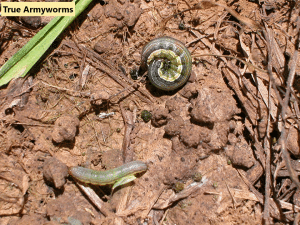Management options
| Insecticide (Trade Names) for ARMYWORMS (True and Fall) | Lb Active Ingredient per Acre | Amount Formulation per Acre | Performance Rating |
|---|---|---|---|
| chlorantraniliprole (Vantacor 5 SC) | 0.047 - 0.067 | 1.2 - 1.71 oz | 9 |
| chlorantraniliprole, λ-cyhalothrin (Besiege) | See label | 6 - 10 oz | 9 |
| methomyl (Lannate LV 2.4) | 0.225 - 0.45 | 12 - 24 oz | 7 |
| spinetoram (Radiant SC 1) | 0.023 - 0.047 | 3 - 6 oz | 9? |
| spinosad (Blackhawk 36% WDG) | 0.038 - 0.074 | 1.7 - 3.3 oz | 8 |
| β-cyfluthrin (Baythroid XL 1) | 0.014 - 0.019 | 1.8 - 2.4 oz | 8 |
| γ-cyhalothrin (Declare 1.25) | 0.01 - 0.015 | 1.02 - 1.54 oz | 8 |
| λ-cyhalothrin (Warrior II 2.08) | 0.02 - 0.03 | 1.28 - 1.92 oz | 8 |
| Z-cypermethrin (Mustang Maxx 0.8) | 0.02 - 0.025 | 3.2 - 4 oz | 8 |
- Avoid planting before the Hessian fly free date (Oct. 15) as infestations of fall armyworm almost always occur in early planted wheat, especially for wheat planted in September.


